Pre-Finished Modular Plaster Panels
The Design and Construction Process
Incorporating modular custom plaster panels into a building design is best done through collaborative efforts. The typical process begins when the design and basic specifications developed by the architect or designer are reviewed with the fabricator to be sure that all custom and special requirements can be met. This includes a review of panel sizes, shapes, textures, colors and installation needs. A joint review early in the design process may uncover potential cost savings or design enhancements not otherwise apparent that can be worked into a final design solution.
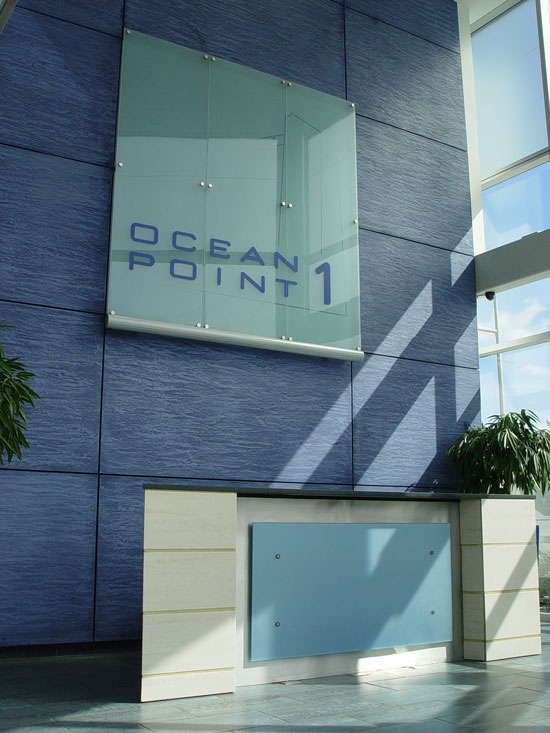
Photo courtesy of ArmourFX, a division of Armourcoat Surface Finishes, Inc.
Modular plaster panels can be designed to meet a full range of needs and be readily incorporated into a standard construction process.
Once the design is finalized, the order placed and scheduled, then skilled workers create the layout for all of the modular pieces. The appropriate substrate is laid out and sized to meet the exact design requirements, including coordination with installation systems. The specified plaster is then applied according to the design and custom specifications. Once cured and finished, the panels are prepared and packaged for shipping to the construction site. Quite often, the installation system is included as part of the total panel system based on either exposed fasteners, direct applied mounting or a concealed hanging system. The most common installation system uses a concealed “Z” clip system similar to many millwork installations that rely on hanging or securing items to a wall or partition.
The benefits of this modular process begin with greater design control, particularly if collaboration begins early and the end product is properly detailed and specified. By using a manufacturer who provides ongoing skilled labor to execute critical design work, there is no need to seek such skilled labor local to the building project, which may not exist in many cases. From a time schedule standpoint, the plaster panel work can be concurrent with on-site construction work, allowing for overlapping schedules without overlapping tradesman and expediting the work overall, since on-site labor time is reduced. This is further helped by the fact that the time-consuming finishing and cleaning tasks are done off site ahead of installation. For large-scale or multi-location designs, products can be created and timed for repetitive installations without sacrificing the potential for customized variations. In all, the modular plaster panels improve the overall design and construction process with the real potential for superior results all around.
Design Considerations
We have seen how modular plaster products can expand the possibility of incorporating the time-proven benefits of plaster by using modern construction techniques to create labor and time savings. Let’s take a closer look at some of the specific design considerations and options available when deciding to incorporate this system into a particular building design.
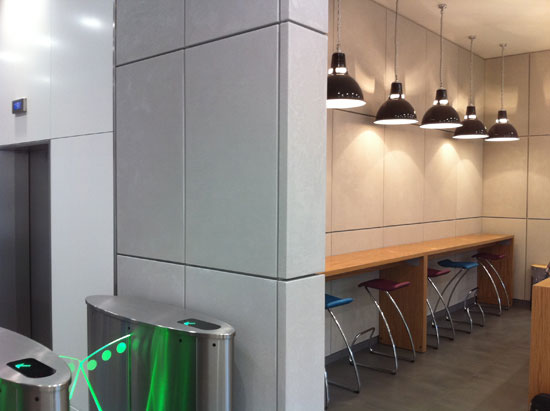
Photo courtesy of ArmourFX, a division of Armourcoat Surface Finishes, Inc.
Modular plaster wall panels can be very successfully used across a full range of building types and in a variety of building locations.
Building Types
The design and construction benefits of modular plaster panel systems can be realized in decorative solutions across virtually all building types. The inherent strength and durability of the products means that they are well suited for high use areas and locations where easy care and maintenance are a concern. Beyond that, commercial buildings such as retail, offices, healthcare, hotels, bars and restaurants can benefit from the ability to easily create specialty shapes or corporate logos plus the ability to replicate product designs across multiple properties. Institutional buildings such as religious facilities, cultural centers, government buildings, museums and educational establishments can use plaster panels to accent or enhance public areas within budget constraints. Residential and retirement living centers can benefit from incorporating three-dimensional, artistic features into the design. Even specialty installations such as movie and TV sets, exhibitions and special event structures, can benefit from easy-to-assemble modular panels that can be fashioned to suit a full range of visual and functional needs. From a visual standpoint, with the ability to specify an almost unlimited range of shapes and design treatments in a huge range of finishes, architects and designers have great artistic scope to meet the needs of virtually any building.
Plaster Finish Options
The hand-crafted, custom nature of modular plaster panels means that there are many surface finish choices available to suit different design conditions. Manufacturers offer over 400 standard colors and finishes as a starting point. Custom colors and thematic effects are also readily available to match or enhance other design elements or existing conditions. For example, the plaster surface can appear smooth and uniform in color or be mottled and variegated. The final sheen can be high, medium, or low gloss or a matte finish. Stone or other natural material appearances can be formed by mixing colors and patterns to emulate natural stone such as travertine, limestone or highly polished marble. Alternatively, the panels can look like poured concrete for urban buildings seeking that look. Overall the color, pattern, and gloss level are all customizable based on the plaster make up and finishing process used.
Plaster Texture
While most plaster panels are made from “polished plaster” recall that this term does not necessarily mean that a smooth surface texture is the only option. Rather it is entirely possible to also specify rough, textured surfaces, striated surfaces, pitted appearances and surfaces with natural materials to emulate nature itself. For the most part, any texture option is available with almost any coloring scheme or pattern.
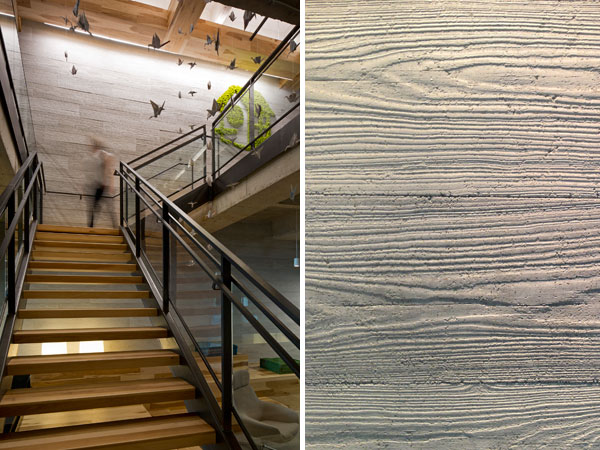
Photos courtesy of ArmourFX, a division of Armourcoat Surface Finishes, Inc.
The plaster can be finished in a variety of textures including smooth, rough, or even wood grained as shown here.
Another texture choice is the creation of wood grain or timber effect panels. These pre-cast products are made as planks cast in a polymer-modified gypsum resin mix. Their design is intended to emulate natural wooden planks with an exposed grain detail and to be used for decorative wall cladding—ideal for interior theming and branding. Two commonly available designs include an original wood grain look or a more rugged look, both of which are typically created from actual Douglas Fir timber planks. The rugged finish is achieved from further hand-distressing of the timber. Available in a range of base wood grain colors, they can be further enhanced once installed with waxes to create a final coloration and finish. Typically, this type of wood grained plaster planks are simply cut on-site as required and then adhered to the wall using a large format tiling adhesive.
Artistic or Custom Shaped Panels
Whether a simple color match, a complex geometric design or an intricate combination of different textures, custom fabricated plaster panels can be used to achieve the desired end result. Manufacturers offer custom color matching used in combination with decorative techniques to create an artistic or creative range that is limited only by the imagination. This can include two-tone effects, multi-color patterns, or the emulation of natural materials. Beyond the color, the shape of panels can be cut or formed as needed to create logos or wall mounted pieces of artwork.
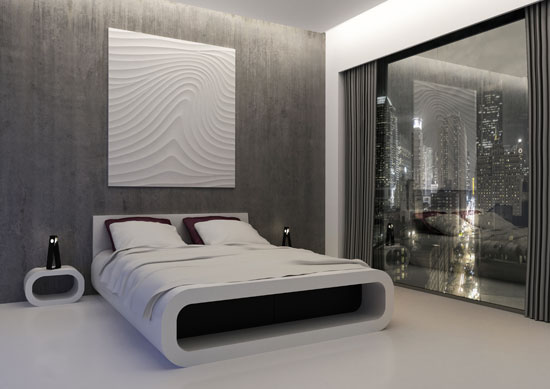
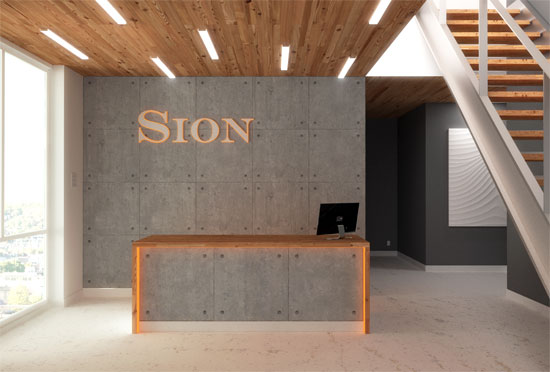
Photos courtesy of ArmourFX, a division of Armourcoat Surface Finishes, Inc.
Custom art shapes, corporate logos, or other three-dimensional shapes can all be custom fabricated in plaster to suit a particular building.
Another creative approach is to use stencils with a designed pattern to add a whole new dimension to plaster surface finishes. Intricate, ornate designs or more geometric repeat patterns can be overlaid to create seamless wall effects, decorative borders or motifs. Textured plaster finishes can form the background that is overlaid through a stencil with a highly polished plaster coat in the same or contrasting color providing a sophisticated or dramatic wall finish. Stenciled designs can be standard or custom made typically using professional grade vinyl. This can have the effect of intricately chiseled or carved stone for a permanent and enduring corporate look. Vinyl stencils can also be used to create applied images such as company logos or free-form wall branding. Color-matching is possible, using Pantone swatches or similar, to ensure a true brand representation.

Photo courtesy of ArmourFX, a division of Armourcoat Surface Finishes, Inc.
Stenciled applications of different plasters and colors can create artistic and varied designs.
Installation
Incorporating modular plaster panels of any type or style into a building design is streamlined when the panels are provided with finished edges and made ready for hanging. Depending on the design and type of panel, modular panel systems can be fitted using high strength tile adhesive, aluminum rail system, or French cleats/Z-clips. We have commented already how wood grain planks are often directly adhered to walls, and this may be suitable for other panels too in some cases. It is more common to use an aluminum mounting system, however with the Z-clip system being the most popular.
Z-clips provide fast installation and ease of hanging the modular panels. Two sets of aluminum members are used. The first is secured along the wall to receive the panels usually with pre-drilled holes for quick and easy attachment. The second set of aluminum members is secured to the back of the panels, sometimes in the factory. The panels are then hung in the field by simply aligning the two sets of clips over each other allowing them to come to rest on each other. Note that in this manner, the panels aren’t actually fastened to the wall directly. This means they are also demountable for access to the wall and any mechanical, electrical, plumbing or other services contained there. It also means that panels can be installed and adjusted laterally and vertically for a proper fit. Once in their final position, the aluminum Z-clips are all hidden by the panel with just a quarter inch space between the back of the panel and the wall. In order to be sure that the final appearance is properly displayed, it is important to note on the construction documents whether the panel is intended to hang horizontally or vertically.
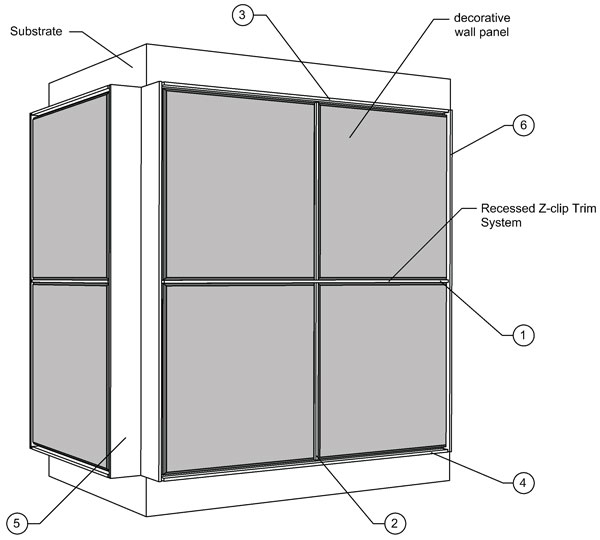
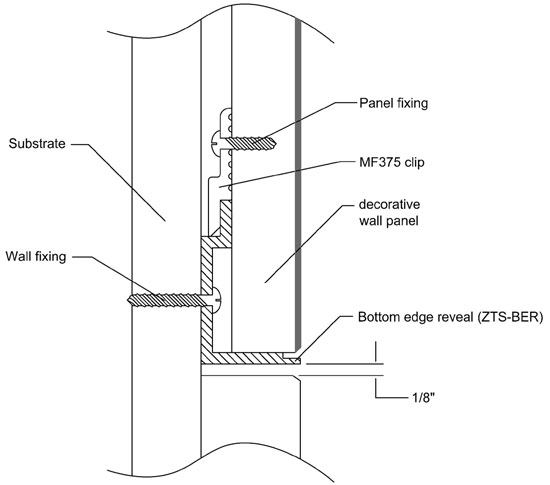
Images courtesy of ArmourFX, a division of Armourcoat Surface Finishes, Inc.
Modular plaster panels can be installed using concealed fasteners in the form of Z-clips or channels with varying degrees of separation possible between the panels (e.g. narrow, wide, etc.).









